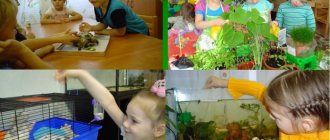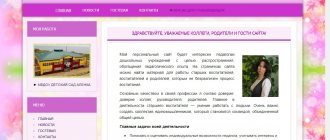GAME ACTIVITIES
As you know, means are that with the help of which activity is carried out. Let us recall (Chapter 2) that the means of activity are classified into five groups: material, informational, linguistic, logical, and mathematical. Let's consider the means of gaming activity for each of these groups.
Material resources
. Speaking about material means, it is necessary to note the fact that for the game there must be a specially allocated and limited (at least mentally) space: a chess board, a card table, a theater, a circus, a stadium, a TV or computer screen, chairs arranged one at a time. others and depicting a train, etc. and so on. Even when the boys play hide and seek in the yard, they discuss in advance where they can’t run and hide—it’s a game. Anything beyond them is “outside the game.”
As for the material objects used for play activities, when analyzing their entirety, we encounter certain difficulties in constructing a unified classification of them. It would seem that the objects of play activity are toys
. Toys are defined as “specially made items for children’s games” (see, for example: [150, vol. I, article “Toys”]). Indeed, the world of toys is extremely wide. Their detailed classification is given in the above-mentioned article. Toys can be very diverse in purpose, scale, and cost. From tiny “kindersurprises” to such an exotic example as the amusing regiments of young Peter I, his amusing flotilla on Lake Pleshcheyevo. These were toys in the full sense of the word.
At the same time, let’s imagine the following example: a boy picked up a twig. In his games, a twig can be a saber, a horse on which he rides, and anything else. a toy for him
- but
not specially made
. Or a “specially made” building block in a child’s imagination can be a horse, a truck, or a medical syringe. What psychologists call “game substitution of objects” occurs [82, 146].
Next, let us imagine such examples. Children play "school". They use real pens and pencils. toys for them
, but these items were made for completely different purposes.
Moreover, in adult games, real objects can become toys. For example, collecting. If collecting does not have scientific or artistic purposes, then it is a type of game. Then collectibles become toys
: postage stamps, coins, matchbox labels, etc.
up to cars, tanks and even ships. But these items were not created specifically for games
, especially not for children's games.
In addition, there are material objects (entire classes of them) specially created for play, but which one cannot dare to call “toys”: a chessboard with a set of pieces, a deck of cards (and children also play them), a billiard table, game machine guns, fishing rod, spinning rod for amateur fishing, hunting rifle, etc. right down to theatrical props.
In addition, living “toys”: indoor plants, pets, if they do not perform official functions (cats, dogs, fish in an aquarium, birds in cages, etc.).
So what then, what class of objects can be called “toys”?! Willy-nilly, we have to agree with J. Bruner: “we do not have a toy theory” [17].
The only classification that suggests itself based on what has been said regarding the material means of gaming activity is:
- means specially created (or introduced, for example, decorative pets) for play, possibly by the player himself and used strictly for its intended purpose;
- means in the form of improvised game objects - game replacement of objects in the imagination of the player (players);
- material objects created for other purposes and used as means of play.
Information media.
Recently, games and toys using information media—microprocessors, computers, and the Internet—have become widespread.
Language means.
Games, quite understandably, use languages - both natural and artificial. In particular, in childhood, games are a means of language development. Children, while playing, exchange their vocabulary and enrich their vocabulary. True, unfortunately, they often use expressions that are, as they say, far from the norms of the literary language.
In addition - an interesting phenomenon - a child who finds himself in a foreign-language environment, in games with children, literally instantly masters a foreign spoken language, for which adults require great and lengthy efforts.
The development of natural language is also facilitated by many special games: “word games”, “guess the word”, the famous game “Scrabble”, etc.
In addition, artificial languages are also used in games. A deck of cards is an example of an artificial language. Or records of chess moves: “the grandmaster went E2 - E4” is another example. Not to mention the special languages of gaming arts, for example, the language of music.
Logical means.
Many games require the use of a logical apparatus, sometimes quite powerful. For example, chess, preference. At the same time, in childhood, games contribute to the development of the child’s logical thinking. For example, various kinds of puzzles, Rubik's cube, many computer games, etc.
Mathematical tools.
There is hardly any need to talk about the use of mathematical means in gaming activities. If, for example, the calculation of the probabilities of winning in certain situations begins, then such a “calculator” has a desire not to play, but to win, i.e. it becomes a kind of professional activity, but not a game.
So, we have examined the logical structure of gaming activity, its forms, methods, and means. In the next and final section we will look at its time structure.
§ 5.3.
Organization of the process
Gaming activities
(temporal structure)
Starting to consider temporarily
th structure of the game, first of all, let's try to highlight its
unit
.
At one time D.B. Elkonin identified the role that the child assumes as an “indecomposable unit of play that preserves the properties of the whole.” “... it can be argued that it is the role and the actions organically associated with it that represent the basic, further indecomposable unit of the developed form of play” [193]. Following D.B. Elkonin, many authors began to repeat this idea that the main unit of the game is the role: “The main unit of the game is the role. In addition to the role, the structure of the game includes play action (actions to fulfill the role), playful use of objects (substitution), relationships between children” [82, 146]. It is strange that this thought of D.B. El horse meat has become so widespread. Firstly, a “unit” such as a role can only refer to a role-playing game, and most games, obviously, are not such. Further, the question arises: if a child plays alone, this is a game of “one unit,” and if ten children play, it is a game of “ten units”? And if two or three children play the same role, how then do you count “units”? Finally, the unit of play, as a unit of any activity, must lie in the temporal plane, and not in the spatial one.
It is known that the generally accepted unit of activity is action.
as a relatively integral and complete part of it.
If in all types of human activity its unit is action, then why should there be a “unit” of some other nature in play activity? The conclusion involuntarily suggests itself: the unit of the game is the game action .
And any game is divided into these game actions: - in football, hockey, these actions are an attack, as well as a penalty kick, a penalty kick, a corner kick;
- in athletics - race;
- in cards - distribution, in other games - con;
- when playing hide and seek, tag - con;
- in chess, billiards - a game;
- during design - a product (“sand cake”, pyramid, etc.);
- in the theater - mise-en-scène;
- in cinema - frame;
- and so on.
In complex games, primarily in the performing arts and sports, the duration of the game is divided into certain parts: in the theater these are scenes and actions (acts), in cinema - series, in sports - halves, etc. In most cases, the duration of the game is limited only by the desires and time capabilities of the players; in children, it is also limited by the requirements of the daily routine, etc.
As in any activity, a game can have a preparatory phase, a technological phase
(the actual conduct of the game),
the final
(
reflexive
)
phase
.
In some cases, the preparatory phase can be quite long and complex - for example, preparing costumes and masks for a carnival sometimes takes longer than the carnival itself. In other cases - very short - for example, when playing "hide and seek" - this is a "counting game". In third cases, the game (most) begins without preliminary preparation - playing cards, roulette, etc.
A separate issue is the final, reflexive phase of the game. Its most important moment is the moment of self-esteem
. Especially for a child. The child evaluates himself - his dexterity, his skills, his successes - in comparison with others. In this game the child is first, and in another game other children are first: they are better than him, able to fulfill the requirements of the game, etc. From this comparison follows the child’s independent, conscious assessment of his specific capabilities. This is completely different from the assessment he receives from others; here for the first time the child begins to evaluate his actions himself.
Self-esteem is also important in the game for an adult. reflection is important
and
the first kind
(what am I like, what was my behavior in the game, etc.) and, in the case of a group, collective game -
reflection of the second kind
as an understanding of interpersonal communication, as a player’s understanding of other players, as well as finding out how other players understand him, his behavior in the game, personal characteristics, etc. This allows the player to further adjust not only his behavior in the game, but also his entire activity in general. That is, game reflection is a powerful means of self-education.
Thus, in a short chapter we tried to cover the entire structure of the methodology of gaming activity: its characteristics (features and principles); logical structure (forms, methods, means); temporary structure. Naturally, this was only a first estimate of the game’s methodology.
In conclusion, we note that gaming activity is an amazing and mysterious phenomenon, like no other type of human activity - neither in nature, nor in scale, nor in its functions. Indeed, no other type of human activity has so many areas of application:
- play as a means of enjoyment;
- play as a means of self-expression and self-affirmation;
— game as a means of development and learning (didactic games);
- play as a means of treatment (play therapy);
- game as a means of relaxation and pastime;
- play as a means of spiritual development and enrichment (theater, music);
- a game as a means to brighten up loneliness, and at the same time as a means of communication with other people, as a means of meeting people, joining a company or supporting it;
- play as a means to give affection and tenderness (to children, pets);
- play as a means of livelihood (professional actors, athletes);
- gaming as a means of enrichment (sharps);
— a game as a means of designing systems (business games, etc.)
- and so on.
Despite all the mystery of gaming activity, play for a person is a wonderful gift of nature, a gift of the gods.
Chapter 6
COMPARATIVE ANALYSIS
ORGANIZATIONS OF DIFFERENT TYPES
ACTIVITIES
In the course of presenting the text, we have already had to repeatedly compare individual aspects of the organization of various types of activities. Here, in this section, we will try to make such a comparison systematically, in the logic of the main provisions set out in our work, namely: by considering the main characteristics, logical structure and organization of the activity process (its time structure), which, in in particular, is reflected in tables 10.1, 10.2, 10.3.
From these tables it is clear that, firstly, the organization of both scientific and practical activities is an integral system with a clearly defined logical structure, characteristics and implementation process. Secondly, that the structural components of the organization of these two types of activities are basically the same. Thirdly, the content of these components often coincides, and in other cases has its own specifics.
The most fundamental difference in the organization of scientific and practical activities is, obviously, the fact that in scientific research activities it is impossible to unambiguously determine its goal in each specific project. New scientific knowledge should appear only as a result of this activity, as a result of the implementation of the project. The source material is more clearly defined - that scientific knowledge that has already been accumulated by the time scientific research begins. A paradox arises: in order to organize an activity, organize a research project, it is necessary to have an ultimate goal as a normatively specified result of activity, the result of the project. But in this form, the goal cannot be normatively specified in scientific research. In this regard, the goal of scientific research is formulated, as a rule, non-specifically, in verbs, so to speak, of an imperfect form: to investigate, formulate, etc.
In practical activities, as a rule, no specific and definite ideas are given about the result of the activity, the result of the implementation of a particular pedagogical (educational) project. However, the requirements for the result are always such that they bring it at least to a level of certainty at which it is already possible to make a decision about the feasibility and novelty of the project. The latter can always be correlated with previous samples, similar in type and scale, or with the real state of the pedagogical (educational) process.
In general, obviously, science and practice in modern conditions of the development of society in relation to each other have become similar to opposite sexes necessary for the reproduction of offspring - the further development of civilization. At the same time, science probably plays the role of the feminine principle as a more subtle and capricious object. Practice is the role of the masculine principle: it is more rude, straightforward and demanding.
In science, knowledge of what exactly we do not know is perhaps no less important than positive knowledge itself. True, an atmosphere of rejection often arises around such results. After all, even physicists, saying that a negative result is also a result, more often than not want to simply console a loser colleague, and try to avoid the negative result itself. However, in science, complexity due to misunderstanding is generally regarded as a temporarily unavoidable and tolerable phenomenon. And the researcher himself can most often “maneuver” at any moment - change the subject or method of research, etc.
In practical activities, complexity due to misunderstanding is most often regarded as an unacceptable value.
| Table 10 comparative analysis of the organization of various types of activities | ||||
| Table 10.1 activity characteristics | ||||
| Characteristics | Organization of scientific and pedagogical (research) activities | Organization of practical pedagogical (educational) activities | Organization of educational activities | Organization of gaming activities |
| Features of the activity | 1. Limitation of the purpose of scientific work; the goal is set in advance. 2. Continuity of research. 3. The rigor of the conceptual and terminological apparatus. 4. Mandatory publication of results. 5. Pluralism of scientific opinions. 6. Communicativeness of scientific activities (scientific communications. 7. Implementation of results into practice | 1. Uniqueness and unpredictability, the presence of free will. 2. Adaptability. 3. The ability to formulate goals, the goals of productive activity are formed in the process of the activity itself. 4. The ability to resist destructive trends; self-organization, self-development | 1. Focus on mastering other types of activities. 2. Focus on oneself, on the subject. 3. Constant innovation. 4. Limited free will. 5. The influence of age-related sensitivity. 6. Consistent mastery of methods of activity characteristic of all types of organizational culture. 7. Compliance with educational paradigms of a particular historical period | 1. Free activity. 2. Exit from the framework of real life. 3. The presence of specific frameworks of space and time. 4. Emotional and volitional tension. 5. Availability of rules. 6. Isolation and mystery. 7. The presence of the phenomenon of “flirting”, “plan” of the game, passion. 8. Voluntary association of people in associations, teams |
| Operating principles | Principles of scientific knowledge. 1. The principle of determinism. 2. The principle of correspondence. 3. The principle of complementarity | 1. The principle of hierarchy. 2. The principle of integrity. 3. The principle of communication. 4. The principle of historicity. 5. The principle of necessary diversity | 1. The principle of cultural transmission. 2. The principle of socialization. 3. The principle of consistency. 4. The principle of self-determination | 1. The principle of reflection and transformation. 2. The principle of self-expression. 3. Development principle |
| Conditions of operation | Motivational, personnel, material and technical, scientific and methodological, organizational, financial, regulatory, information | |||
| Norms: 1) general, 2) specific | Universal ethical, hygienic and other standards | |||
| Standards of scientific ethics | Norms of pedagogical ethics | School hygiene standards |
Table 10.2
↑ Game as a type of activity
A game
- this is a type of activity that is aimed at satisfying spiritual needs and the goal of which is not the production of a material product, but the process itself - relaxation, entertainment.
Characteristic features of the game:
- Occurs in a conditional situation, which, as a rule, changes quickly.
- Certain items are used during the game
- Aimed at satisfying the interests of its participants
- Promotes personality development, enriches it, equips it with the necessary skills.
↑ Labor as a type of activity
Work
is a human activity aimed at obtaining a practically useful result, which makes it possible to satisfy one’s needs.
In the process of labor activity, a person produces the material and spiritual values he needs. Unlike study and play, work requires a person to have certain training or qualifications,
for example: a miner cannot perform a surgical operation.
Qualification -
the level of knowledge, abilities, skills and competence that characterizes readiness to perform a certain type of professional activity.
Characteristic features of work:
- Feasibility
- Focus on achieving programmed expected results
- Availability of skills, abilities, knowledge.
- Practical usefulness
- Availability of result
- Personal development
- Transformation of the external human environment






